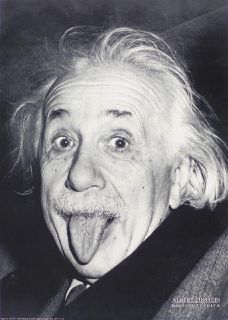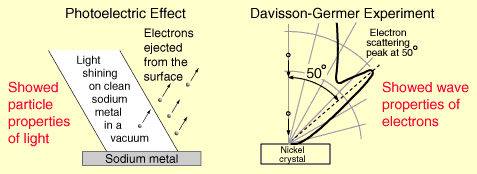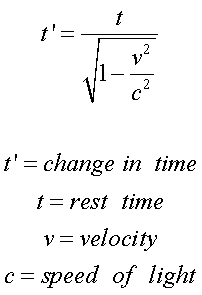Albert Einstein and Cosmology go hand in hand. Sure
there have been some remarkable discoveries by some
remarkable men since Albert Einstein released is
Special and General Theories of Relativity, but the
work by Einstein paved the way.There are so many
websites dedicated to Albert Einstein that I will
not go into his biographical data - just do a Google
search, and you will see what I mean. Of course, my
favorite picture of him is:

He does what he wants and I like that.
A misconception regarding Einstein's work is that
while he did win a Nobel Prize, it was not because
of his works in Relativity - his Nobel Prize was for
the discovery of the Photo-Electric Effect.
Hyperphysics has an excellent section on the
photo-electric effect:

(Image
Credit)
The photoelectric effect basically
proves the duality of
light:
When
light strikes a piece of metal,
like the image above, the photon from the
light are
of a high enough energy to eject electrons on the
surface of the metal.
Its easy to remember that nothing
travels faster than
light, but there are other
things to conceder:
-
Light in a Vacuum travels at
299,792,458 m/s
-
Light travels slower than that
depending on the medium - i.e. the refractive
nature of the medium
Why is this? Because
light is also a
particle and like all other particles, they
interact. The limit on the speed of
light is because
light is also a particle. This may not make sense,
but Relativity helps to explain this.
The Theory of Relativity:
In 1905, Albert Einstein published
his Special Theory of Relativity and in 1916, his
General Theory of Relativity was released. While
Einstein is best known for his theories, the ideas
of Relativity really began with Galileo Galilei.
This "Galilean Relativity" was called by Einstein as
common sense (and not in the way as an insult, more
like a base of understanding). An example of this
"common sense" is the train and baby analogy:
A train is moving at 'x'
velocity past a train station. On the train, a
baby is crawling in the direction of the train.
Observers in the train see the baby crawling at
'y' speed. As the train passes the train
station, observers standing still see the baby
moving at the speed of x + y.
The idea of Relativity is that to
any observer, the speed of an object depends on
their time frame. I may see my friend throw a
football and I can see the ball move at a particular
speed. A plane flying overhead either in the
direction or against the direction of the moving
football will witness a different speed. One is not
more correct than another, just another frame of
reference. This is the essence of Relativity.
What make Einstein's theory of
Relativity special is that it addresses objects that
are traveling at high speeds - like the speed of
light. Astronomers often use the term "relativistic"
when describing or studying a certain phenomenon.
This term that can have two meanings:
Discussing the Theory of Relativity
will take far too many pages - and I am by no means
an expert. Two very good books for additional
reading are:
Einstein, Albert. Relativity. The
Special and the General Theory. Crown Trade
Paperbacks. New York, 1961.
Sartori, Leo. Understanding
Relativity. A Simplified Approach to Einstein's
Theories. University of California Press.
Berkeley, 1996.
A basic summary of Einstein's works:
-
The laws of
physics are the same
in any reference frame
-
The speed of
light is the same
for all observers
-
"A moving clock runs slow" - in
other words, time slows down to the outside
observer
-
The length of a reference object
is shorter to the outside observer
Keep in mind that these changes in
time and length are very minute, and any noticeable
changes will only occur as that reference frame
travels closer to the speed of
light.
Our nearest star is Proxima Centauri
Alpha (Alpha Centauri) at 4.3 light years away. That
means if I had a
light powerful enough to reach this
star, it will take 4.3 light years to get there. If
I were to get on a space ship and fly to Alpha
Centauri, I am now in a different reference frame
with my own clock - as I reach velocities near the
speed of
light, I notice that it does not take 4.3
years to reach my target, it is actually less.
The twin paradox is a famous example
of Relativity in action:
There are two brothers that are
twins. At the age of 30, one of the twins takes
a cruise on a rocket that is traveling 99% the
speed of
light. He does this for a straight
year, returning to Earth on his 31st birthday.
To his surprise, his brother is 7 years older.

The formula above is the formula to
use if you want to determine your own reference
frame.
While all of this talk of slowing
time sounds fantastic - and hypothesis' abound such
as travel beyond the speed of
light for time travel
- but there are two boundaries to overcome also
based on Relativity:
The second statement means this: if
I were traveling at the speed of
light, or pretty
close to it (i.e. 98 to 99%), my mass would become
infinite. The energy required to move infinite mass
would also be infinite.
Some rules of
physics still apply
regardless of the frame of reference.
To end this section, I will regale a
joke/riddle I heard as a child:
If you are traveling in a car at
the speed of
light, and you turn on your
headlights, do they work?
The answer to this question is yes -
because the speed of
light is the same for ALL
observers, including those traveling at the speed of
light.
Back to Top |

